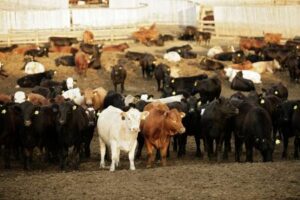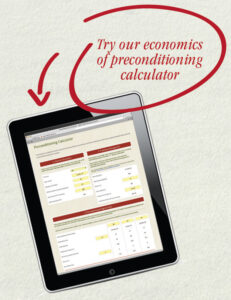Calculator: What is the Value of Preconditioning Calves?
Preconditioning is a management method that prepares calves to enter the feedlot, reducing stress and disease susceptibility. Preconditioned calves are weaned at least 30-45 days prior to sale, put on a vaccination program, and introduced to processed feedstuffs, feedbunks and waterbowls. The intent is to spread out the stressors that calves experience: weaning, vaccination, transportation, unfamiliar animals and environment, dietary changes, etc., so that the immune system is not overwhelmed.
Many studies have shown that preconditioned calves have a lower cost of gain at the feedlot with improved rates of gain and feed efficiency, as well as lower treatment rates and death loss. These attributes contribute to higher profits in later phases of beef production and allows cattle buyers to pay a premium for preconditioned calves. Additional weight gain during the preconditioning phase as well as reduced shrinkage associated with stress during transportation and the marketing process also contributes to higher returns from preconditioned calves.
While there are clear benefits to the feedlot for purchasing preconditioned calves, is it worthwhile to the cow-calf producer to retain ownership?
A study by Carlberg, J.G., et al. (2013)1 showed that from October 2011 through October 2012, two Alberta auction marts had an average premium of $7.97/cwt on cattle that went through a preconditioning program. A summary by F.A. Thrift et al. (2011)2 indicates that buyers paid more for preconditioned relative to non-preconditioned calves with premium values ranging from US$1.43 to US$6.15/cwt; the magnitude of the premiums was affected by cattle appearance, seller reputation as well as marketing channel.

Price premiums on preconditioned calves do not necessarily result in positive net returns for cow-calf producers as the extra costs of preconditioning and price variations due to weight increase and market seasonality can negatively impact revenue. To accurately assess the potential economic returns from preconditioning, a producer should have a good idea of their cost structure and realistic projections on cattle prices and precondition premiums based on current market situations and experience from previous preconditioned sales.
With funding by the National Check-off and Canada’s Beef Science Cluster, the Beef Cattle Research Council has developed the value of preconditioning decision tool. This new tool is a spreadsheet designed to help Canadian producersevaluate the economic opportunity from preconditioning. It is comprised of five steps. The first four steps require: general calf information, anticipated price under traditional management, preconditioning costs, and projected prices for non-preconditioned and preconditioned calves based on weight and seasonal adjustments. With a robust database on historical Canadian cattle prices, the tool allows producers to compare their projections to the 10 year provincial average. The fifth step then provides a summary of estimated net returns from preconditioning and projected breakeven price premiums of three different precondition programs (30, 45, 60 days).
— Click to open the online value of preconditioning decision tool. —
Example
The following example uses 10 year average calf prices to reflect a seasonal price year. (Note: the 10 year and 5 year seasonality are consistent, with 2003/04 having minimal impact on feeder price seasonality).
Step 1: General Information
A calf was born in mid-March at 85 lbs. It is expected to be weaned at around 220 days (mid-October). With an average daily weight gain of 1.8 lbs, the projected weaning weight is 481 lbs.

Step 2: Traditional Management
Under traditional management,this calf will be marketed in mid-October. It is expected to lose 6% of its body weight during transportation and marketing process. Consequently, the final pay weight is expected to be 452 lbs. Assuming an average price of $130/cwt for 400-500 lbs steers marketed in mid-October, this calf is expected to bring about $588 to the producer. (Note:A free price projection mobile app is available from Canfax. Search for CFX Pro in the iTunes Store or BlackBerry App World.)

Step 3: Preconditioning Program Costs
The alternative marketing strategy is to add value to this calf through a preconditioning program and sell it at a heavier weight. The precondition phrase typically lasts for 30 to 60 days. A producer can run three scenarios by varying the length of the program period (30, 45 and 60 days). Marketing time of each scenario will be calculated based on the length of precondition period and marketing weight based on the average daily gain projected by the producer. Shrinkage of preconditioned calves is expected to be smaller than non-preconditioned calves at 3% due to reduced stress. Total preconditioning costs will be calculated based on values entered for each cost item. (Note: Any cell in yellow can be adjusted by the producer.)

Step 4: Projected Price and Premium
Prices are adjusted to reflect the heavier weights – as price trends lower as weights increase. In addition, the change in marketing time (from October to November, or December in this example) will also affect calf prices. Producers can project average prices (Based Price) and preconditioning premiums (Final Price) for each scenario by moving the sliding scales associated with the seasonal price adjustment and preconditioned price premiums. Current market information on feed costs, calf supply and demand should be taken into account when projecting marketing price, to determine if this is a seasonal year or not. The 10 year average weight and seasonal adjustments based on historical steer prices up to 750 lbs are provided for a reference.
The below table shows the average price for 500-600 lbs calves marketed in November and December typically have an 8% discount versus the 400-500 lbs calves marketed in October. The 30-45 day preconditioned calves are expected have a 4% premium over non-preconditioned calves; the premium on 60 day preconditioned calves is expected to be slightly lower at 3%, as a calf could become overly fleshy in a longer precondition period. These premiums can be adjusted by the producer to reflect local opportunities in the market. Gross revenues of the three scenarios are calculated based on pay weights and projected final prices.

Step 5: Results
All three preconditioning programs are projected to bring in higher gross revenue compared to traditional management. However, the increased revenue of the 30 day program is not large enough to cover the extra preconditioning costs and therefore results in a negative net return. In order for the 30 day precondition program to be profitable, the producer would need to look for a market where he or she can sell with at least a 5% premium at $639/head. The 45 and 60 day examples are projected to have a profitable net return.


—
1 Carlberg, J.G., and R.J. Hogan, Jr. “Factors Affecting Cattle Prices at Alberta Auction Marts” Research Report for ITS Global, 2013
2 F. A. Thrift and T. A. Thrift “Review: Update on preconditioning beef calves prior to sale by cow-calf producers” Professional Animal Scientist 2011 27:73-82
Learn more about the economics of preconditioning
Want More Money For Your Calves? Study Says Weaning & Preconditioning Pays
Beef Magazine
http://beefmagazine.com/ranch-management/want-more-money-your-calves-study-says-weaning-preconditioning-pays
Click here to subscribe to the BCRC Blog and receive email notifications when new content is posted.
The sharing or reprinting of this BCRC Blog article is welcome and encouraged. Please provide acknowledgement to the Beef Cattle Research Council, list the website address, www.BeefResearch.ca, and let us know you chose to share the article by emailing us at info@beefresearch.ca.
We welcome your questions, comments and suggestions. Contact us directly or generate public discussion by posting your thoughts below.